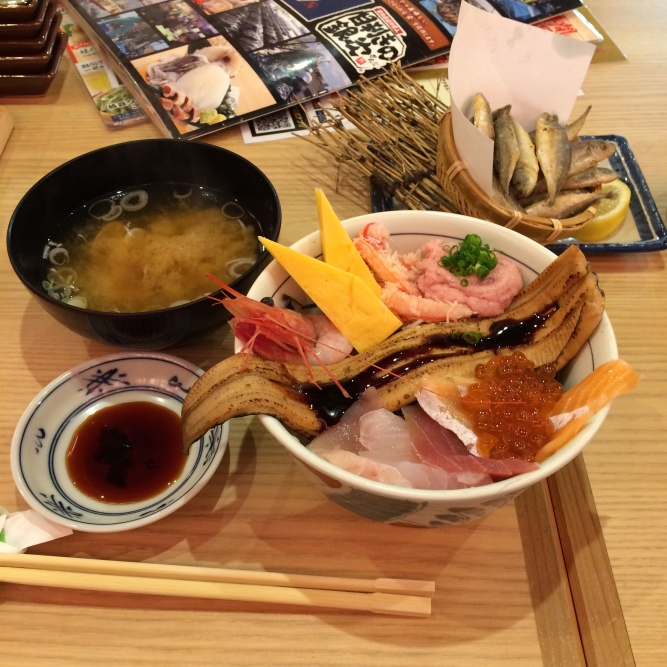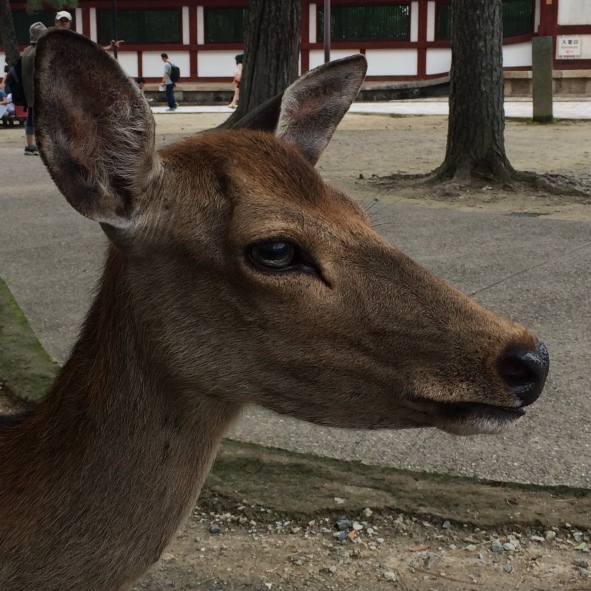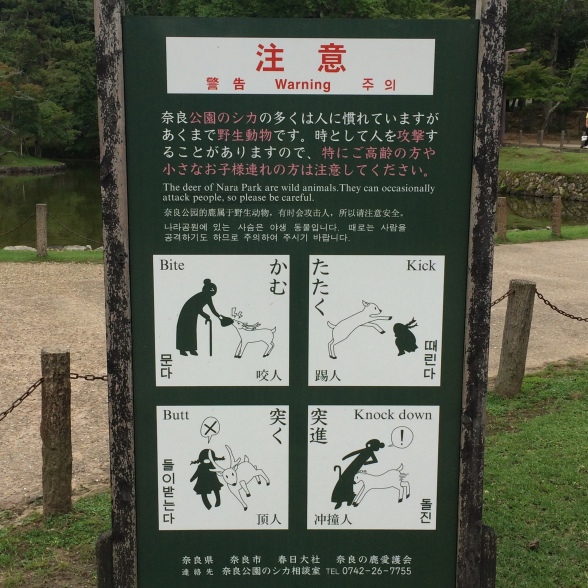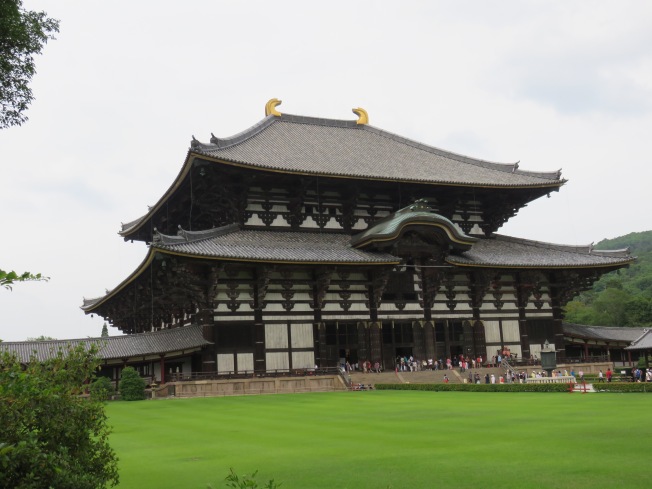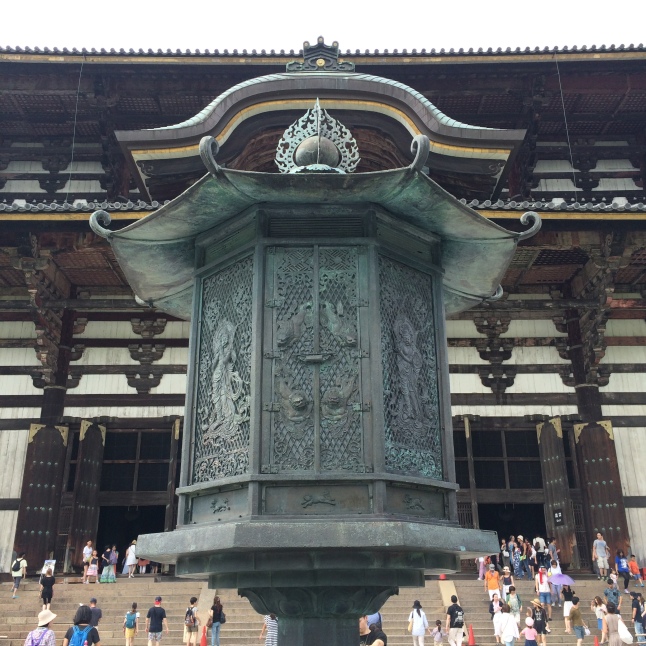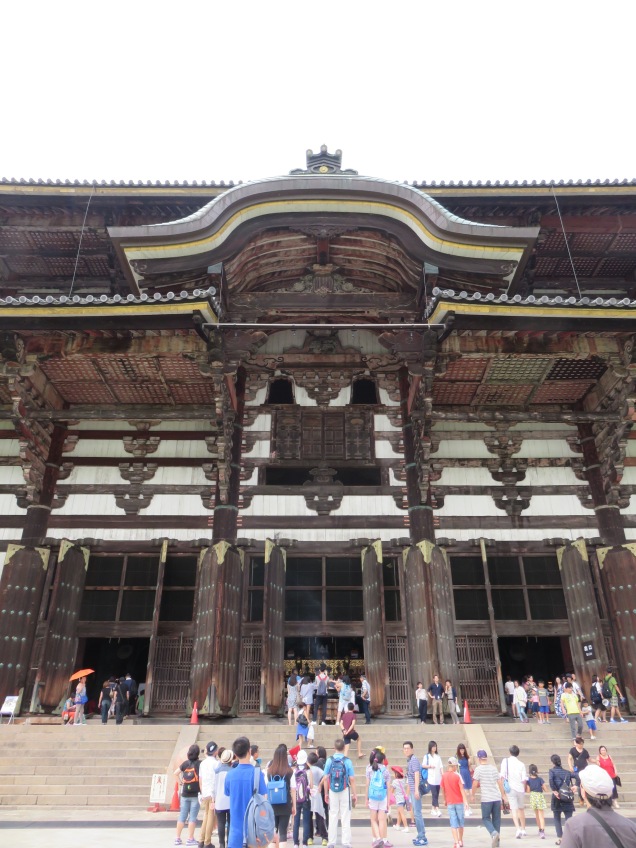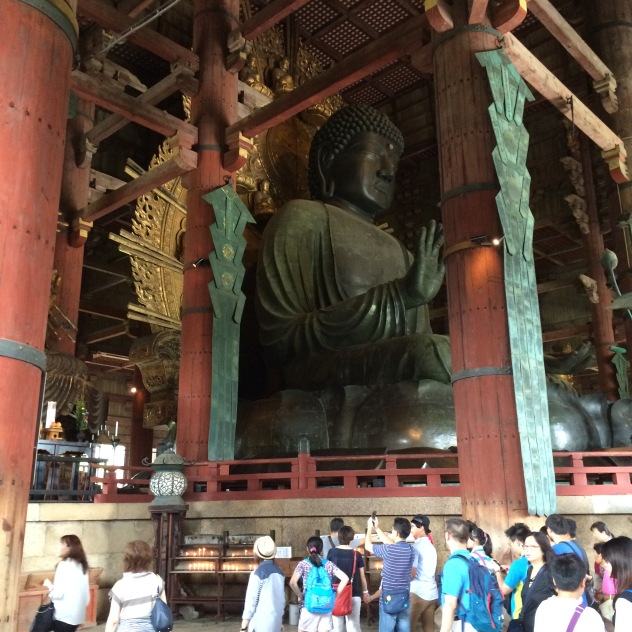Such is the proximity of Nara to Kyoto by train (44 minutes over a distance of approx. 40km) that I was able to leave late morning, my notebook has an entry at 1125, I’m not sure if that was written on the train or just before.
The rest of the page reads as follows:
“I am hitting all the tourist hits since I am just as much the tourist. I am treading the well worn path and following directions and the path of others, I do not know if this makes me very conventional or just a diligent tourist.”
There are reasons that these places are tourist hits and while I might not be blazing new trails, it is still a new trail for me.
Once I arrived in Nara, the first thing to do was to get in the tourist office for a couple of maps and to ask a few questions about buses and the like. Although I wanted to have lunch first and despite the heat had a little wander across the way to a shopping street. Even though I’d had fish for dinner, I still felt like eating more fish and following the bright posters on the sandwich board outside one building headed up some stairs to a seafood restaurant.
Like most cities there are also restaurants in Japan which I’d guess you’d call theme restaurants probably part of a chain and this one had all sorts of paraphernalia you’d associate with fishing and the sea. It was also still one of the restaurants in Japan where you can smoke as I noted from the smell emanating from two tables away. I used to smoke but stopped more than 13 years ago now and have really come to dislike it.
My choices out of the menu, great looking pictures but what about the reality?
I’d say that’s pretty close to accurate in comparison with the menu, the donburi was 952 Yen which is £5.28, yes you read that correctly.
Fortified by my lunch I made my way to the bus stop to head for the main attraction of Nara which is the Tōdai-ji (eastern Great Temple) which houses the world’s largest bronze statue of the Buddha in Daibutsu-den (Great Buddha Hall) and is a National Treasure.
As you walk towards the park that surrounds the temple grounds first thing you see are the Sika Deer, I’m not sure what the percentage of tourists that come for the deer or the temple complex is but nevertheless it is quite a sight to see both tourist and deep wandering freely around the complex. The deer were considered to be divine and sacred due to a visit from one of the four gods of Kasuga Shrine. After World War II, the deer were officially stripped of their sacred/divine status and were instead designated as national treasures.
It is possible to feed the deer and deer crackers (Shika Senbei) can be purchased from vendors around the park.
It seems I wasn’t the only one to be feeling the heat that day!
The deer are generally pretty docile until you give them the possibility of something to eat then they become not exactly aggressive but they will butt you and nip at you. It is quite a sight to see how different people react to being swarmed by deer. There are quite often shrieks from teenagers and people in their twenties for whom this might be the closest they get to wild animals ever. Some people would throw the crackers away from them as soon the deer approached.
There are also some deer that will bow for their food or just bow if you bow to them.
I did feed the deer and I thought I’d found a quiet spot with only three deer, the next thing you know I was surrounded 360º by deer and getting prodded, butted and nipped at. Somewhere out there there is photographic proof of my deer feeding in Australia or Taiwan since that seemed to where the tourists taking pictures of me were from. There was no shrieking or throwing of crackers from me since I figured the deer wouldn’t actually eat me!
In my quest to take pictures different from everybody else I now realize that I missed out on telling the whole story in some respects. A wide shot showing the grounds and just how many deer are around would have good to have. I actually realized this sitting on the bus back to the station and was tempted to go back but didn’t maybe next time if there is a next time. Despite the large number of people visiting, it never really felt crowded as there is plenty to see in the ample park land.
Leading up to to the Daibutsu-den, one of the first structures is the Nandaimon Gate (Great South Gate) built in the 12th Century, which houses two temple guardian statues carved from wood that stand at 28 feet tall.

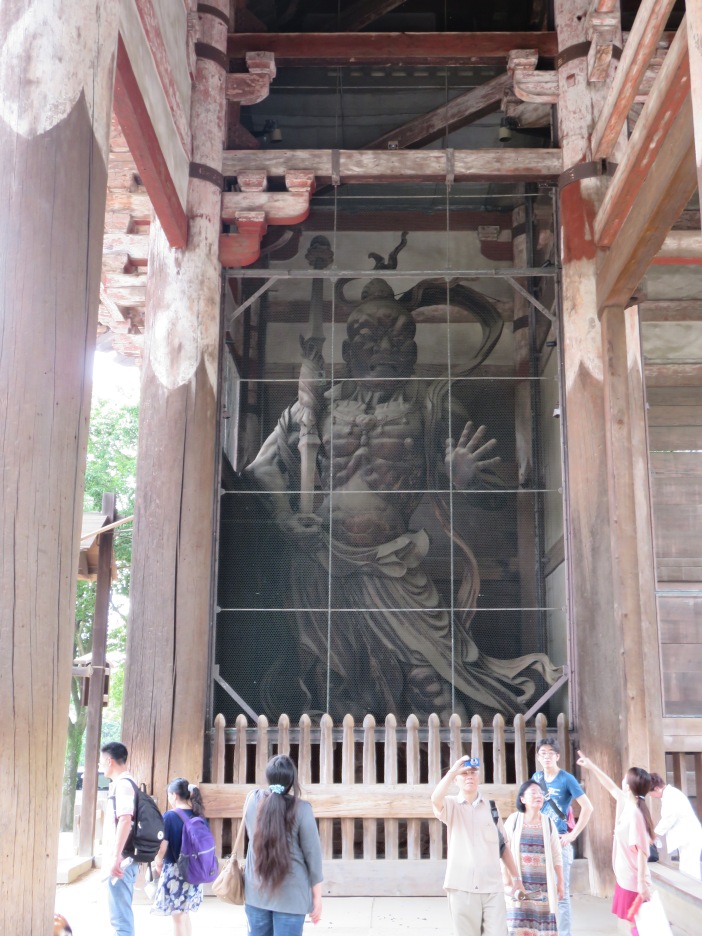
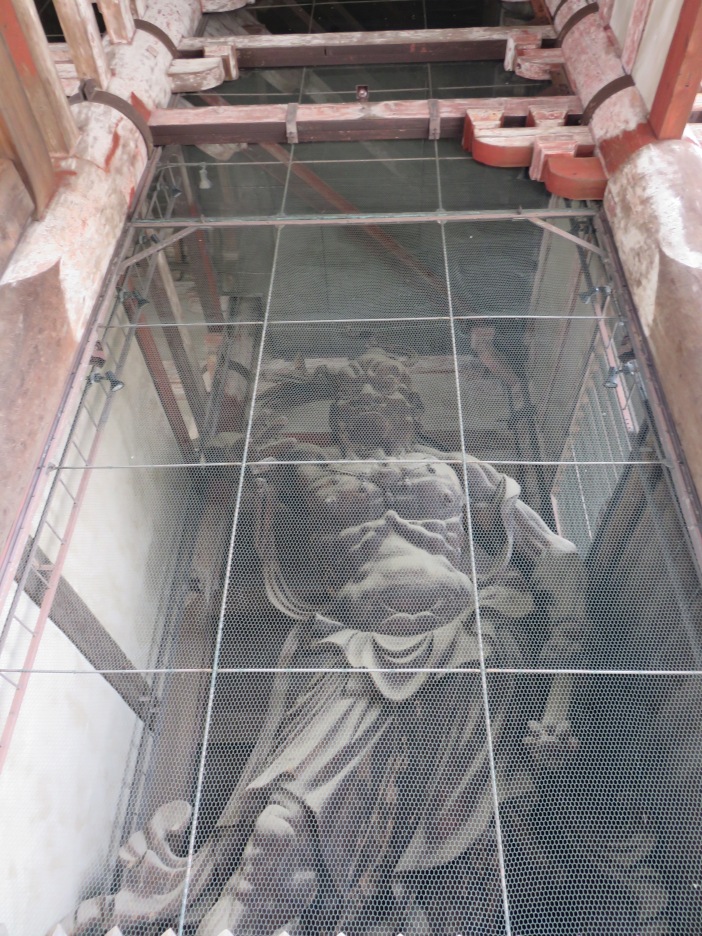
The Nio, the muscular guardians of the Buddha are according to Wikipedia a pair known as Ungyo who has a closed mouth and Angyo who is shown with an open mouthed expression. The pair were carved by Unkei and Kaikei and their workshop members. They are an impressive and imposing sight, arresting in their features as well as the technical achievement in carving them.
Once through the gate, the path leads towards the Daibutsu-den (Great Buddha Hall) which was once the largest wooden structure in the world.
Its difficult to convey how big the building is but the people dotted around in the pictures should do something to illustrate this.
The Buddha is 14.98 m (49.1 ft) in height and 28 m across and weighs in at 500 tonnes.
That is one big Buddha!
Also within the structure are other exhibits which show the skill involved in carving the wooden sculptures.
I’m not even sure which way I wandered off but for a while I enjoyed the shaded wooded areas of the park as headed towards the hillside.
It is only now after looking properly at a map that it seems I did meander a fair bit.
Breaking cover from the trees I found myself at the bottom of some stairs which led up to another hall called Nigatsu-do. I do remember mentally asking myself if I really wanted to try to walk up the east entrance stairs in the heat.
Details on the steps.
At the top the view was like this:
Nigatsu-do (The Hall of the Second Month) itself is decorated with lanterns hanging outside.
From there I wandered off in the general direction of south east, with no real fixed itinerary for my day which is either great or mindless depending on your perspective, I found myself by a set of shops selling calligraphy items to souvenir food. By souvenir food, I mean carefully packaged boxes of local specialties which can range from rice crackers to sweets, think fudge from Cornwall but packaged much better. I did pop into the calligraphy shop if anything just to cool down from their air conditioner.
I’m not one for selfies and have largely kept pictures of myself away from here so far but I did take one by the closed shutter of the shop with somebody else resting.
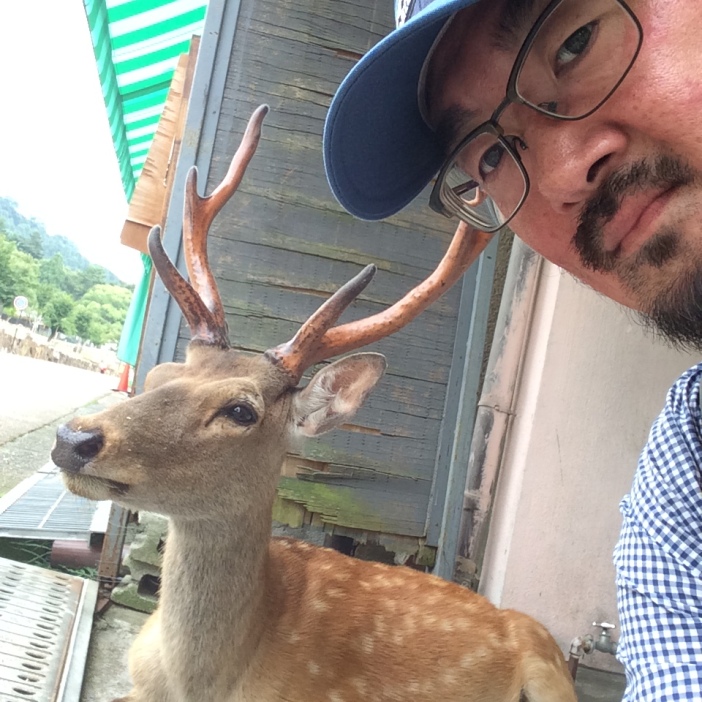
Oh deer, obligatory selfie with Nara resident with interesting head gear.
Even now looking at the map all these months later, I’m not even sure how I managed to go around the park in a seemingly strange route!
I took the path towards the Kasuga Taisha Shrine but with the 5 p.m closing time upon me was not able to think about going inside, still I caught a glimpse of some of the vermillion coloured buildings.
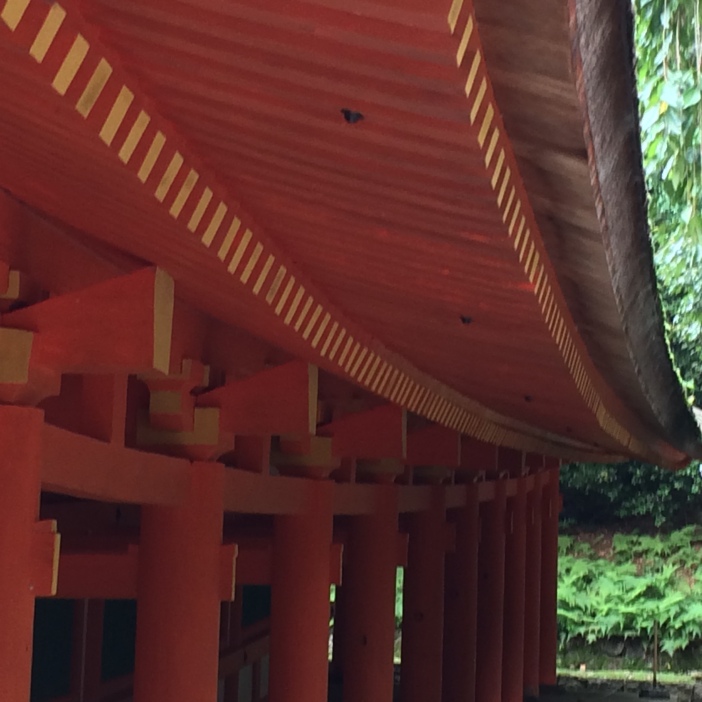
The paths leading to the shrine are lined with approximately 2000 stone lanterns of various shapes and sizes.
As well as the occasional lion:
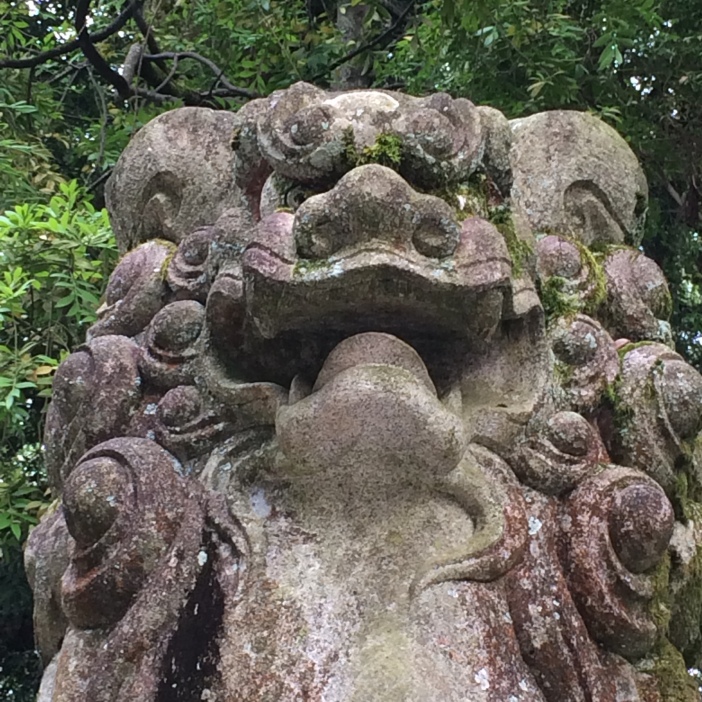
Tiring now, I found a bus stop that had hardly anybody waiting for a bus and checked and rechecked that I was at the right stop to get back to the station. Actually, it was a different bus than the one that I took to get there but it nevertheless got me to the station. For the most part I discovered that most buses will hit the city station at some point in most cities in Japan.
For those of you who might be wondering but I don’t speak or read Japanese, there is English signage in the places that you need it.
I present the side of the train carriage:
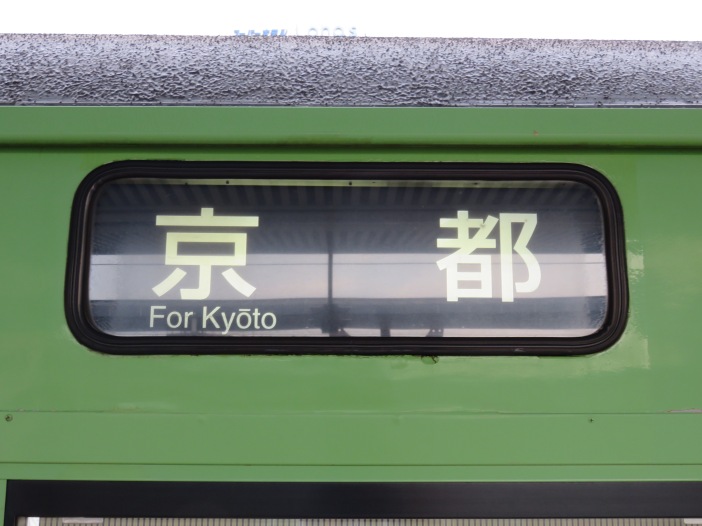
You now also know how Kyoto is written in Japanese!
Later that evening in Kyoto, I met up with my mother who was in town on business and ate at the station that evening. Eating at the station is not the grim affair that you might imagine, in Japan, stations especially the larger ones are joined to department stores or have areas dedicated to restaurants. I’m not sure if I’ve already mentioned that so apologize now if I’ve started to repeat myself.
What did you eat? I hear you ask.
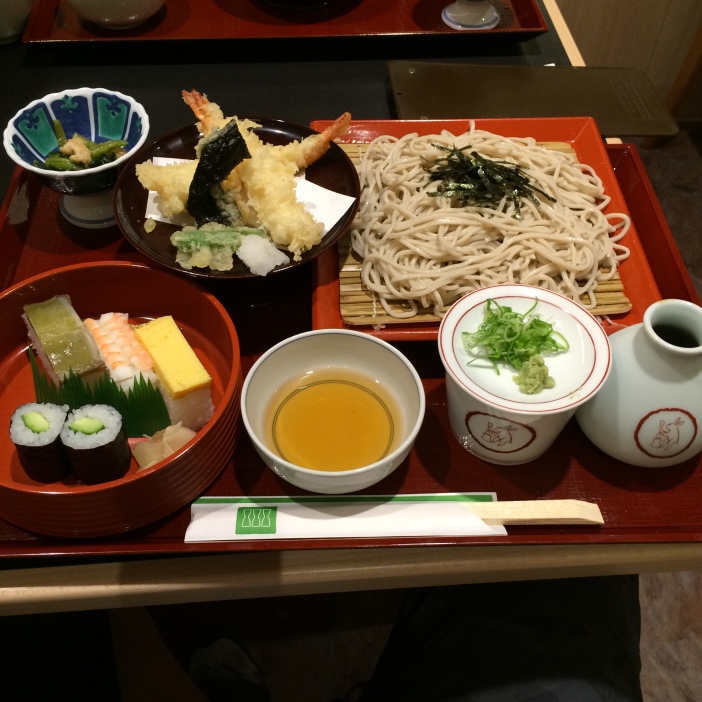
It looks like I had a slightly strange combination but as I’ve mentioned before sometimes that’s what great about eating out is that you can a bit of everything. So on the left is Oshizushihako, pressed sushi which is as it sounds. First the rice is put in a box then the topping and the top part literally presses down. Above that is tempura and zaru soba.

